Birthing Barriers: Designing for Black Birth Equity
- Global Health
- Social Justice

This Designmatters Studio challenged transdisciplinary students to learn about the disparity and dangers facing pregnant Black birthing people in Los Angeles County who are four times more likely than white birthing people to die of complications related to pregnancy and childbirth. Students collaboratively designed a comprehensive multi-modal awareness campaign with the goal of expanding access to equitable child birthing experiences and increasing awareness about choosing Black midwifery to improve health outcomes – for the birthing person, baby and the entire family.
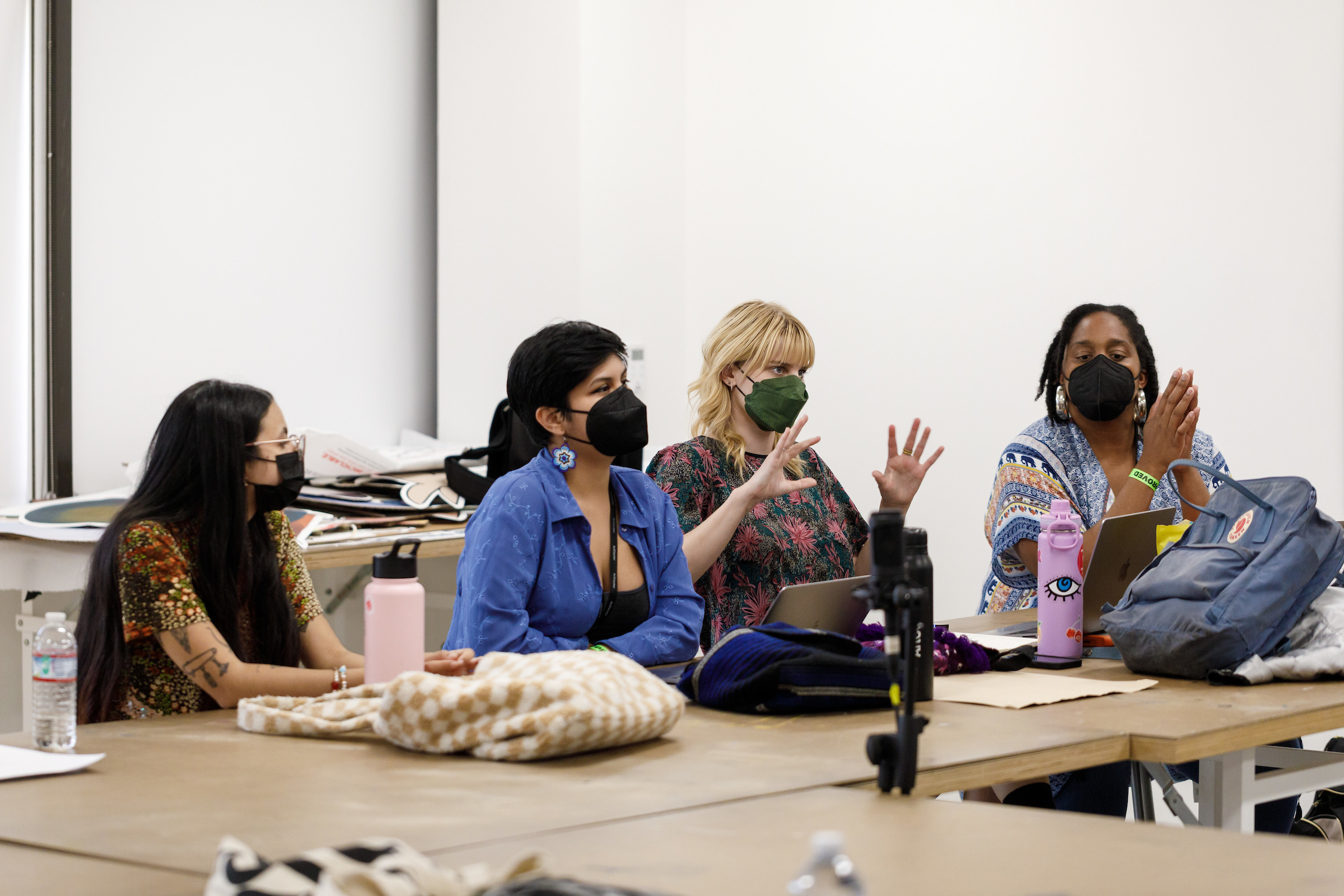
“We had a lot of great resources and guests who shared their stories; the testimonials from women who were mistreated were extremely motivating for the students to do something that counts in the world. Art and design can do wonderful things, especially when you are standing face-to-face with someone who had gone through something terrible, you begin realize the potential of what you can do and how you can help.”
Ranee Henderson, instructor
Project Brief
Transdisciplinary students in this Designmatters Studio learned how systemic racism, lack of midwifery care options and dearth of midwives and doulas of color contribute to an alarming disparity between Black and white birthing people in Los Angeles County. Black babies are three times more likely than white babies to die before their first birthday; likewise statistics shows that Black birthing people are four times more likely than white birthing people to die of complications related to pregnancy and childbirth.
With a goal of facilitating access to equitable birthing experiences and increasing awareness about Black midwives, student teams designed a comprehensive multi-modal campaign targeted to Black birthing people but one that would resonate with birthing people from all backgrounds, cultures and sexual identities.
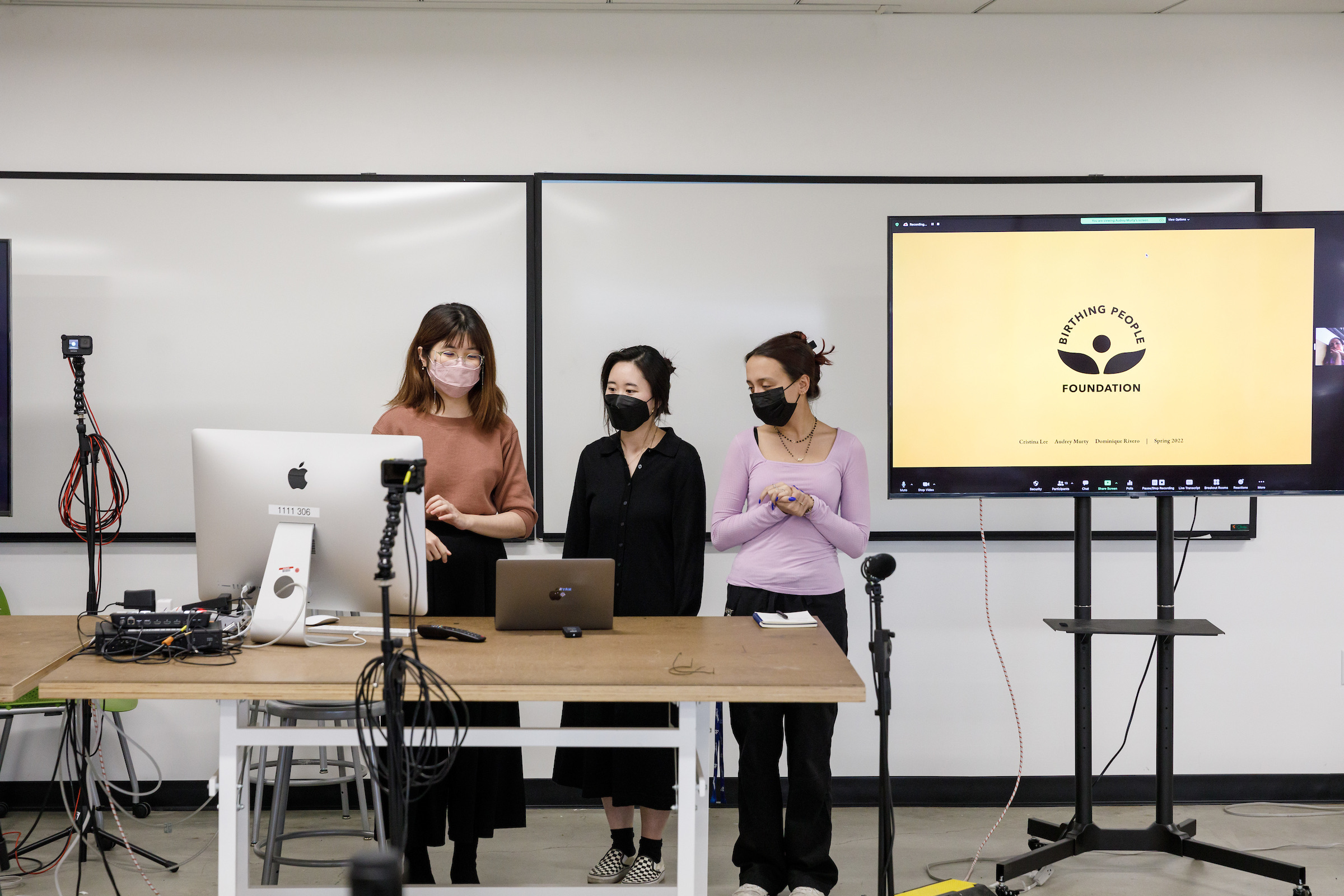
“Access, knowledge, connection and empowerment. This describes the student’s work here. I feel all warm and fuzzy thinking how people could be much more involved and included in their pregnancy experience and not just a passive recipient of care.”
Isis Rose, independent midwife and doula
About Midwifery and the Black Birthing Experience
As far back as ancient Egypt in 1550 BC, midwifery was recognized as a female occupation. Throughout the ages and across cultures, older women passed on medical traditions and trained younger midwives to care for pregnant women before, during and after baby was born as well as offering newborn care and ongoing sexual/reproductive health advice.
According to a Library of Congress blogpost, the practice of midwifery within the African and African American community “has roots dating back to the 17th century when Europeans brought African slave women skilled in midwifery to the United States…for each delivery they made, African American midwives could receive as little as two to three dollars in payment.”
In the early1800s, the burgeoning field of obstetrics (dominated by white men) asserted that their modern scientific techniques were superior for mothers and infants rather than midwives. Incorporating racist and xenophobic views, they declared foreign-born and Black midwives as illiterate, incompetent and ignorant – which eventually resulted in the 1921 passage of the Sheppard-Towner Act, a federally funded statute that regulated midwifery workforces – and curtailed much of their activities.
Hospital doctors and physicians soon replaced most midwives in Northern communities, but African American midwives continued practicing in the rural South. The decline of the practice in the South, however, was noticeable. One newspaper article describes that in the 1920s there “were more than 400 of these midwives; in 1950 only two.”
In the late 20th Century, however, more accepting attitudes about midwives prevailed; even the World Health Organization recommended women should have a natural, normal and humanized birth. Midwives started to regain traction and achieve welcoming recognition as highly-trained and specialized professionals in obstetrics. Today, by some accounts, the profession is more than 90 percent white.
Black pregnant women often suffer disproportionate disparities in health outcomes; the CDC reports that Black women experience maternal mortality at a rate 2 to 3 times higher than white women. Black women are 3 times more likely to die from a pregnancy-related cause than white women. Quality healthcare, underlying conditions, structural racism and implicit bias make up some of the contributing factors.
Lately, there has been a grassroots movement by Black midwives to revive and reenergize the practice, offering competency and compassion for Black birthing people, their babies and their families.
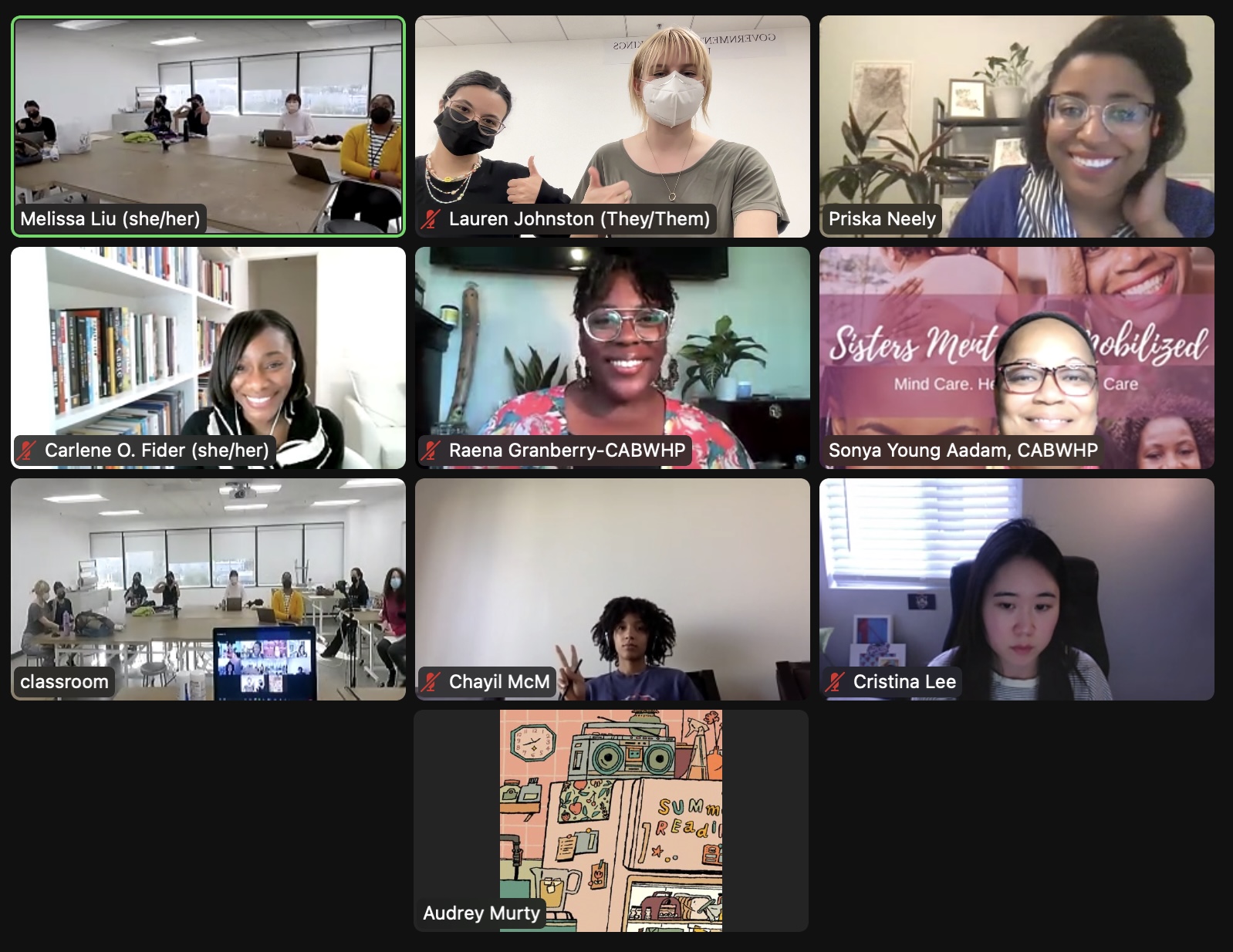
Research and Project Development
Kicking off the studio students were introduced to the founders of Kindred Space LA, a birthing community center in South Los Angeles, who presented an informal discussion about the nature of midwifery and their work as one of the few birthing centers that reaches out to the Black community.
Through questions and answers, the two founders – Allegra Hill and Kimberly Durdin – discussed their professional midwifery careers which led them to create this unique birthing center that serves as medical and emotional support for Black and all POC pregnant people.
Students heard about the history of midwives, especially Black midwives, and the differences between doulas and midwives. There was much discussion about the current health care crises that faces the Black pregnant community. On the average, Black women are 2-3 time more likely to die or have serious complications from their pregnancy. Black babies are dying at a higher rate than white ones. Structural racism contributes to Black pregnant women being typically shuttled quickly through doctor’s appointments with little time for in-depth consultations.
Choosing a midwife allows Black birthing people to have an alternative to the typical brief doctor interactions and impersonal hospitalizations. Students learned that midwifery incorporates more than just medical care, but rather addresses the holistic needs of the pregnant person at all stages of pregnancy and beyond. Local grassroots efforts are seeking to engage and enlighten more Black, POC and the transgendered and binary communities about the option of midwifery.
To demonstrate how midwives assist with a homebirth, Hill shared a personal video of her own experience giving birth. The students witnessed first-hand how midwives attended the couple, gave them proper space, and welcomed the newborn. The gentleness and care demonstrated was emotional and uplifting.
Over the following weeks, students were deeply engaged in researching the topic, both the historical aspects as well as how present-day midwives and pregnant people who are continuing the tradition of supporting the Black birthing experience.
A field trip to Kindred LA provided the students with an up-close sense of how care is administered and the life-affirming work of midwives. Students toured the facilities, observed interactions and gained a better understanding of the issues; the experience also sparked students with tangible opportunities that could fuel their final presentation/campaign element.
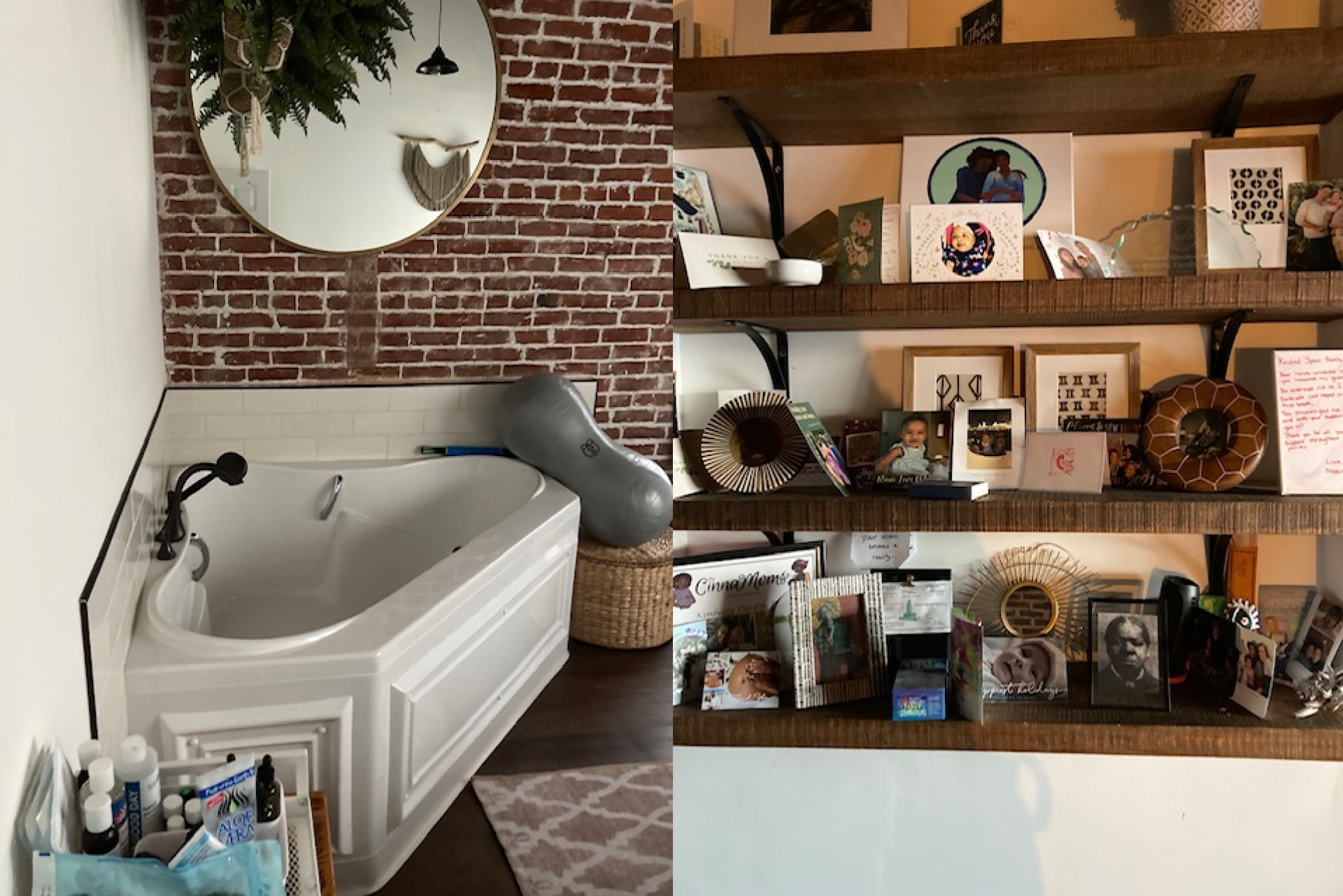
“I am so proud to see how the student’s designs developed over time, how they were able to reflect on what this means to their demographic, and how they placed themselves in their design. All this makes their design more meaningful and authentic. I’m proud they were able to make this personal. And could see how it can impact someone who doesn’t look like them.”
Dr. Carlene Fider, instructor
During the research phase, presentations from experts helped the students deeply understand the topic.
Teams heard from a variety of speakers and panelists who included: Dr. Carlene Fider, professor at Pacific Oaks College who discussed the Social Determinants of Health and Racism in Medical Practice; Isis Rose who operates a birthing and post-partum care facility in Central, Illinois where the bulk of her clients are Black; Dr. Keisha Goode, an assistant professor of Sociology at SUNY Westbury who has done extensive research on Black midwifery in the U.S.; Sonya Young Adan and Raena Granberry of the California Black Women’s Health Project; and Priska Neely, a public radio journalist who reported on birth equity issues.
Students examined the work and writings of New York-based artist Jordan Casteel who paints intimate portraits of friends, lovers, family members as well as neighbors and strangers; her depictions, especially of Black masculinity, offered the students an example of how art can provide alternative narratives and showcase the power of representation.
Realizing that equity for birthing people also extend beyond race into sexual identities, students examined the disparity in the birthing experience for queer and transgendered/non-binary individuals. Students strived to expand their concept – which would include inclusive language – to be welcoming to all pregnant people.
Students engaged in in-class activities that involved how sketching, art-making and portrait design communicates big ideas. They also viewed the documentary, Deliver Us, a film about the growing role of Black midwives in addition to When the Bough Breaks, about post-partum depression.
To prepare students for reaching out and soliciting one-on-one interviews with subjects, instructors presented guidelines and best practices for initiating outreach and conducting interviews.
Additional audio testimonies by midwives and pregnant individuals provided the students with rich personal experiences that would inform their design but also assist them in developing empathy with this population segment.
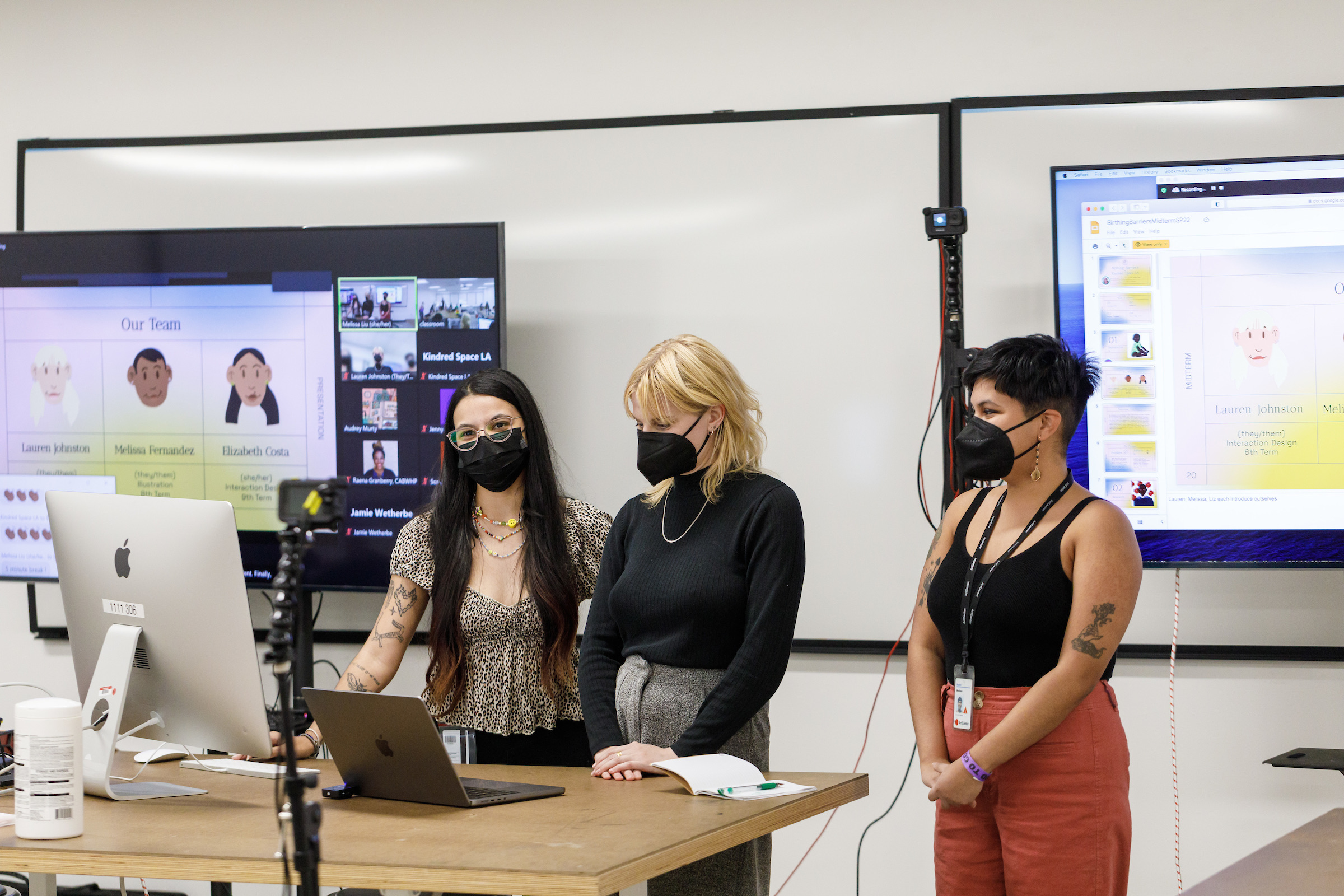
“The thing that called to me about this studio was the inclusivity of it – the emphasis on another marginalized community and finding ways to make that that community can be heard. I’m a woman of color and have experienced the racism in our health care system. But doing the research, I learned things that really surprised me. I did not know how deep and far back and midwifery is, not to mention the brutal history of men who wanted to dominate that field.”
Elizabeth Costa, student (Interaction Design)
Midterm Presentation
Student teams shared their conceptual designs to members of Kindred Space LA and documentary filmmakers Randi Matthews and Jenny Callaghan, ArtCenter faculty and other guests. Before describing their idea, teams explained their research findings and how their findings helped direct their design thinking. Teams shared their overall focus and mission of the project, how it would be created and the impact they expect to achieve.
Students shared ideation that involved creating a website, a mural and an app; they presented mood boards, initial sketches, personas, color pallets and possible next steps they wished to take to make their project come to life.
Honest and heartfelt critique encouraged the students to keep moving forward with their concepts; teams were challenged to expand their ideas, keep up with research and, if possible, field test a prototype.
Following the midterm, students continued to research how their design thinking can mesh with their objectives; teams reached out and conducted interviews with community members who offered constructive feedback on their project concepts.
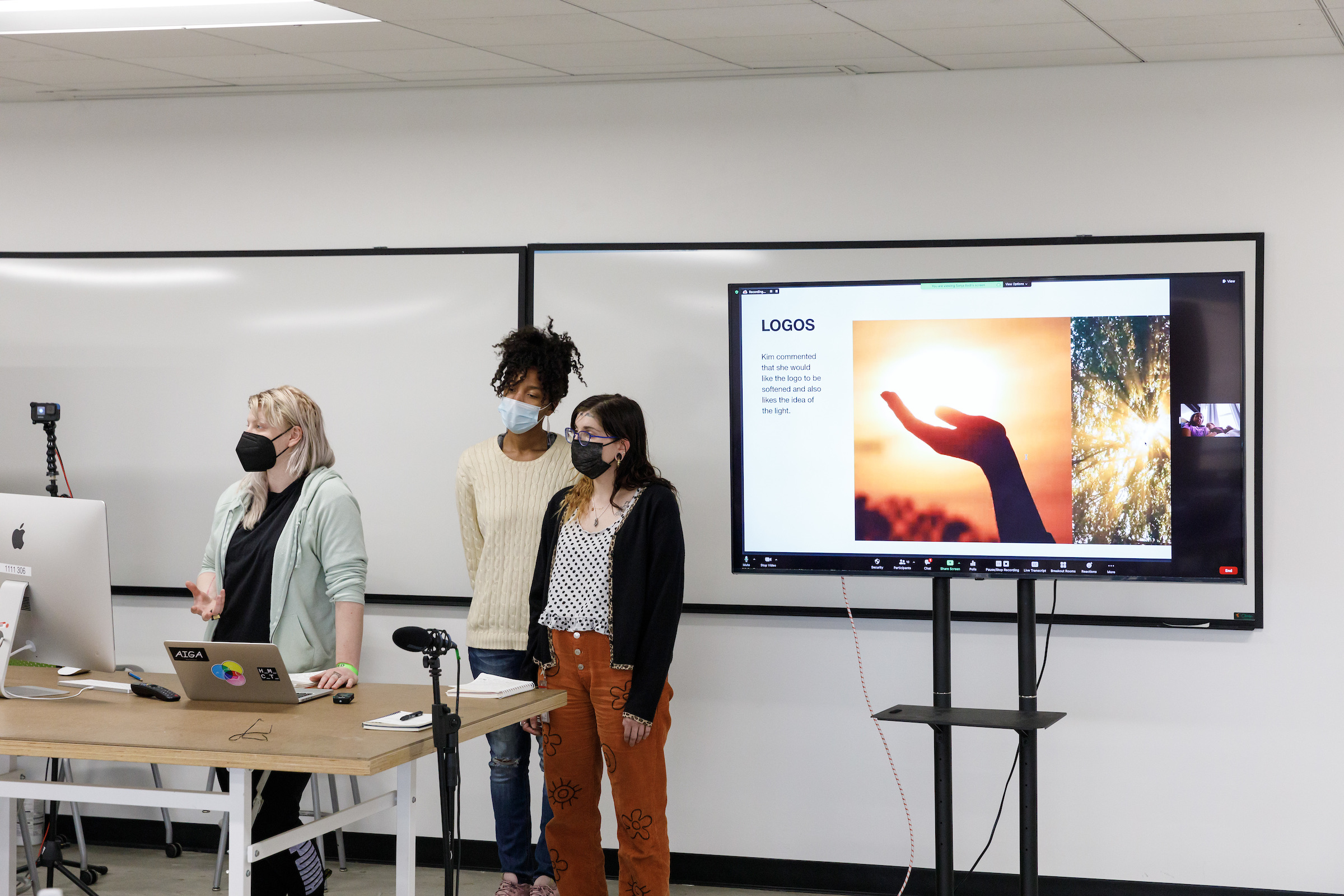
“This studio taught me a lot about Black joy. We started the class with statistics that are sobering, but then we talked about when people are empowered, Black joy appears. Our goal was to listen to people who needed to be heard and to make sure they are heard.”
Sonja Bodi, student (Graphic Design)
Outcomes
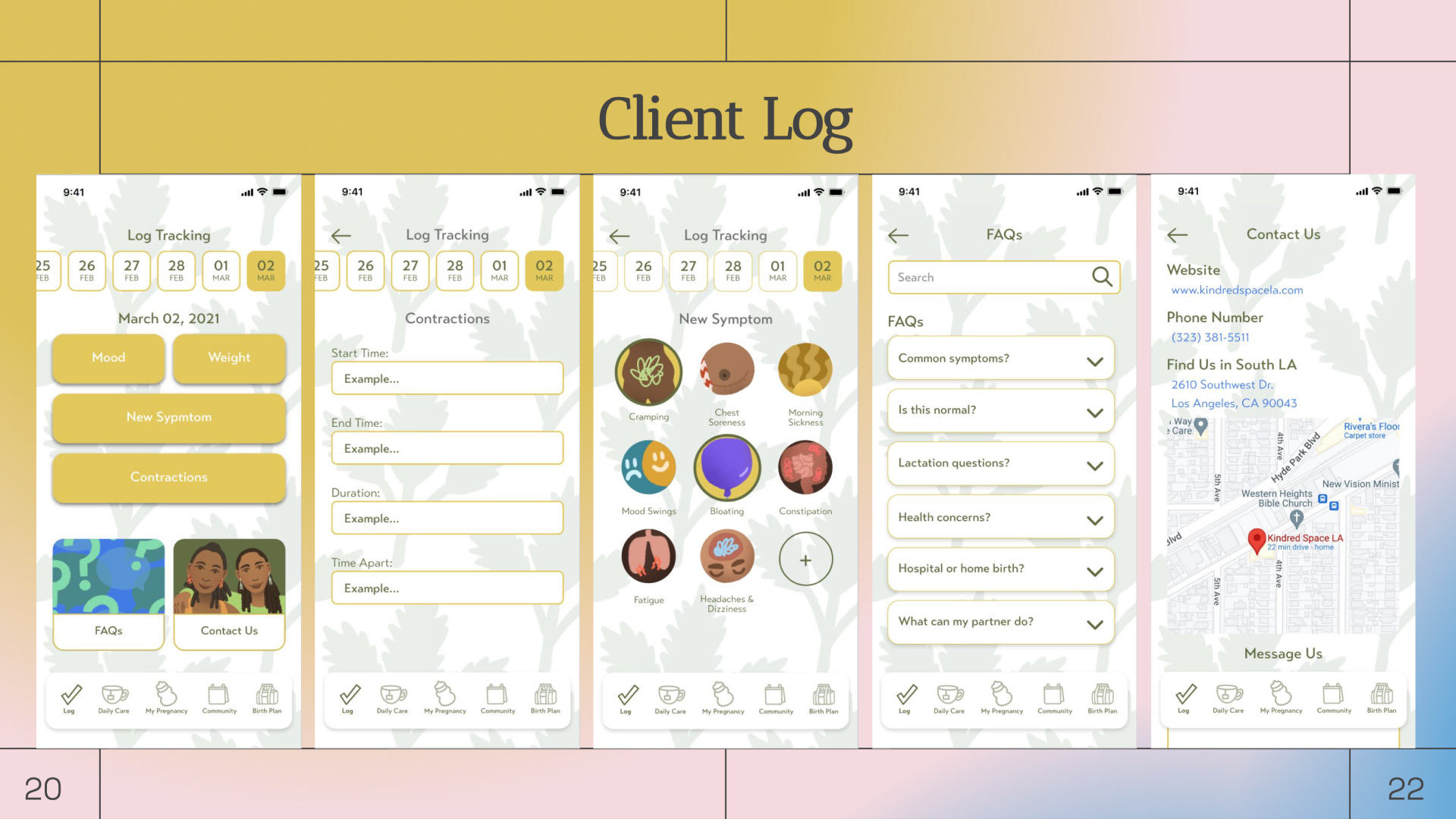 close
close
Kindred Space LA App
Read moreElizabeth Costa, Melissa Fernandez, Lauren Johnston
To serve all their clients, including Black and queer, this app associated with Kindred Space LA offers birthing people a wide range of resources and community connections. Inclusive illustrations will feature BIPOC and queer imagery and will be incorporated into the icon sketches, section and button design. Likewise, inclusive text will allow all users to feel welcome.
Overall, the system will be visually pleasing but neither too busy nor distracting. Navigation will be intuitive and simple.
Key app features: Client Log (to track pregnancy symptoms, mood, weight, etc.), Daily Care checklist, My Pregnancy (tracking baby’s development and what to expect) Community and Birth Plan.
The customizable birth plan can be created and edited here which can be exported and downloaded to share with providers.
A community page will feature upcoming events at Kindred Space LA, moderated and in-person groups (Lactation, etc.) to join or create, and external resources such as food banks and other help for low-income individuals.
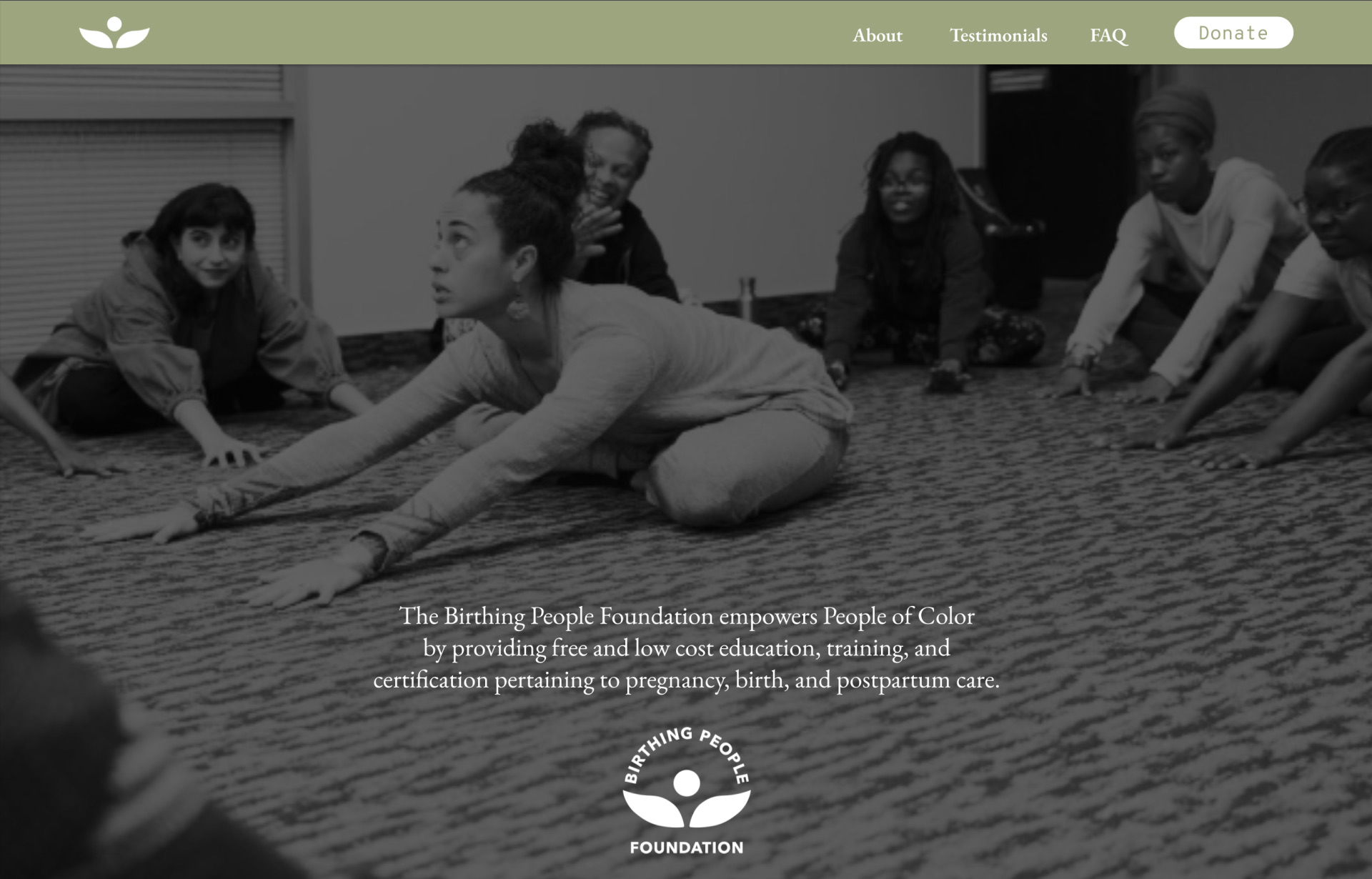 close
close
Birthing People Foundation Website
Read moreCristina Lee, Audrey Murtey, Dominique Rivero
A new stand-alone website, stripping information from the current Kindred Space LA website, will create a unique brand identity for the Birthing People Foundation that supports and empowers Women and POC. The charitable foundation provides free and low cost training, education and certification for birthworkers.
A new logo for the Foundation, inspired by the Kindred Space LA garden, features an abstract design that can either be seen as flower in the garden or two hands holding a baby or other nurturing combinations. The new logo can be applied to a variety of merchandise including tote bags, shirts, and baby clothes.
This website also contains a series of infographics that are associated with Frequently Asked Questions about the birthing experience and what the Foundation is all about.
Using bite-sized text and imagery, the infographics are descriptions, explanations and Calls to Action: “Joy and Love of the Birth Experience,” “Our Culture of Care,” and “Make a Donation.” These simple and effective graphics can also be used for social media posts.
To encourage donations, testimonials will be included from birthworkers and birthing people. Personalized quotes can also populate the website. Readers can meet the team at Kindred Space LA and contact the center for more information or to make donation.
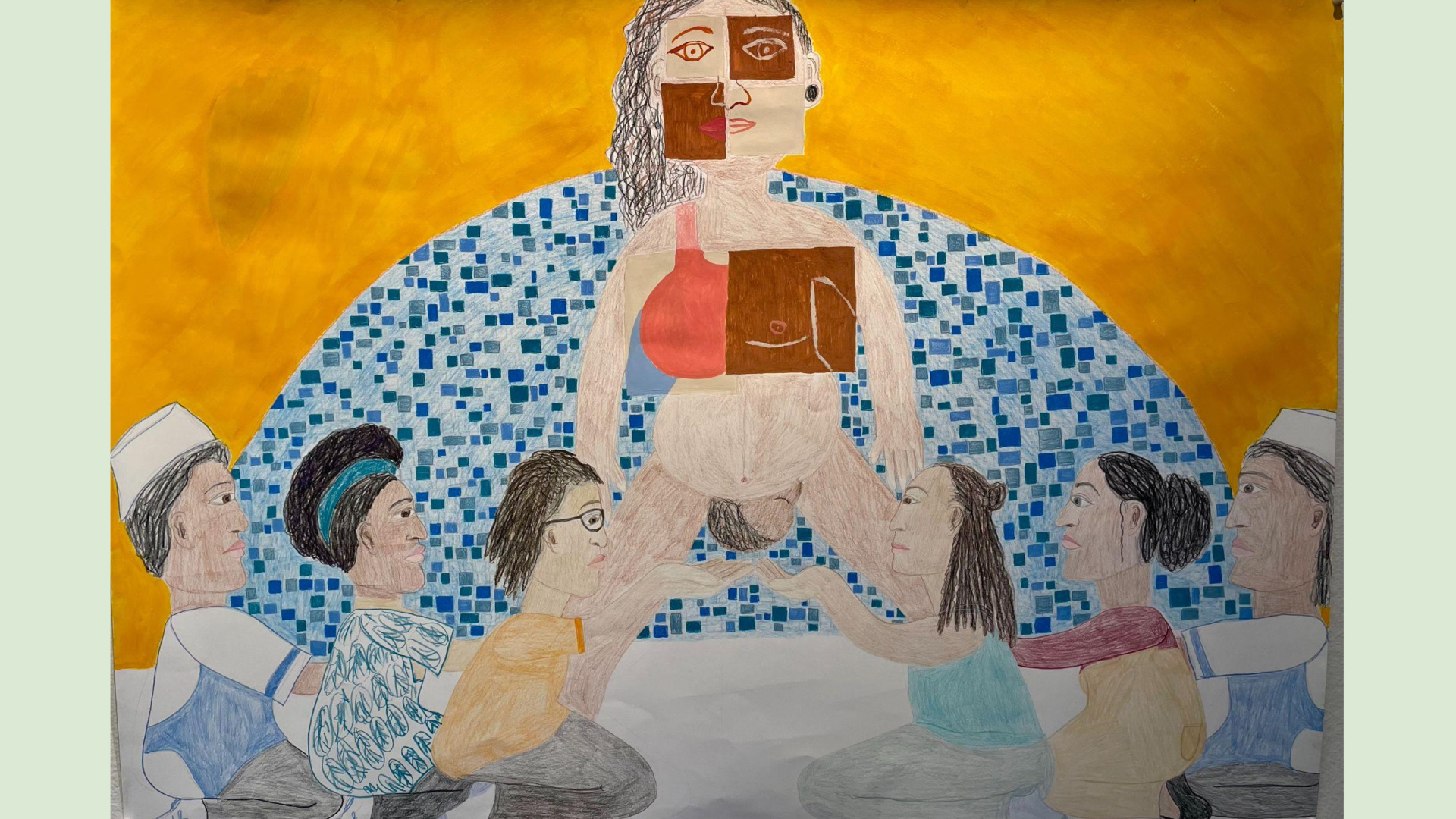 close
close
Red Moon Group: Logos, Murals and Filmed Commercial/PSA
Read moreSonja Bodi, Becca Ford, Chayil McMullan
To update and add dimensionality to the current Birthing People Foundation logo, a new design will incorporate a font created by a Black font designer, Joshua Darden. Iterations on the theme of hands with a glowing light depict the joy and work of the Foundation to support birthworkers of color.
A mural design, inspired by the concept of ‘Bringing Babies to Earth,’ can be installed at Kindred Space LA, either inside or externally. A mosaic of blue tiles, representing water, is the backdrop to the visual that depicts a birthing body with midwives from different eras in the act of “catching” a baby.
To visually explain and depict the midwifery experience, a commercial can be filmed using minimal shooting locations that would include Kindred Space LA, a doctor’s office and a private residence.
A spec script outlines the action and dialogue between a pregnant couple who are experiencing their first baby. A “Baby Agent” encourages the couple to consider midwifery and shows them how Kindred Space LA can personalize their pregnancy and birthing experience. Casting for the commercial could be done using real-life individuals; ArtCenter film students can provide the lighting, crew and camera and editing work.